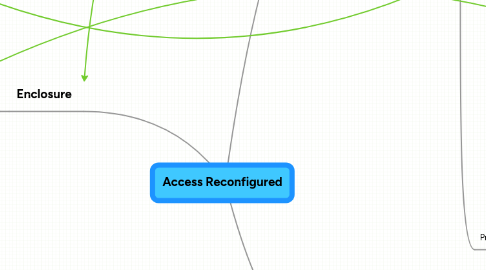
1. Enclosure
1.1. Commercialization
1.1.1. Copyright
1.1.1.1. Expanding restrictions to usage
1.1.1.2. Lengthening terms
1.1.2. Traditional production
1.1.2.1. Exclusive property rights
1.1.2.2. division of labor
1.1.2.3. reduction of transaction costs
1.1.3. Enclosing of once public resources
1.1.3.1. Forests in Britain
1.1.3.2. Users of the resource ultimately lose
1.1.3.3. Commercial use concentrates wealth
1.1.4. the AOL model
1.1.4.1. mediate access to internet resources
1.1.4.2. control or alter content to serve commercial interest
1.1.4.3. No access to underlying technology
1.1.4.4. closed to new applications
1.1.5. Natural rights
1.1.5.1. Right to what you create as private
1.1.5.2. Right to retain fruits of personality and labor
1.1.5.3. Extended to corporations as wells as individuals
1.2. Privacy and surveillance
1.2.1. Carnivore - FBI surveillance system trolls the internet for probative information
2. Commons
2.1. History
2.1.1. Decentralized
2.1.1.1. End to end
2.1.1.2. Technology at the edges
2.1.1.3. Thought to be immune from control
2.1.2. Open access
2.2. Code is law
2.2.1. Internet can be made less regulable
2.2.2. Internet can be made more regulable
2.3. Access
2.3.1. Previously sought as inclusion in something owned by someone else
2.3.2. Internet could be described as free to begin with
2.3.2.1. Should the internet be controlled at all?
2.3.2.2. Is public or private governance necessary or desirable?
2.4. New Public Interest
2.4.1. Open Platforms
2.4.1.1. Access to underlying technology
2.4.1.2. Ability to extend core protocols
2.4.1.3. Freedom to create new applications without restriction on how the underlying technologies are used
2.4.2. Open access to ideas
2.4.2.1. Freedom to use, change, republish ideas
2.4.2.2. Copyleft
2.4.2.2.1. Copyright is automatic
2.4.2.2.2. copyleft releases rights to allow the idea to be repurposed
2.4.3. Open Source
2.4.3.1. New paradigm of production
2.4.3.2. Centered around distribution
2.4.3.3. All ideas are public
2.4.3.4. decentralized: decisions made by the software community
2.4.4. Conversational interactivity
2.4.4.1. unfinished
2.4.4.2. allows different outcomes to be reached
2.4.4.3. predicated on open systems
2.4.5. Multiple publics
2.4.5.1. As opposed to one "public good" carved out by legislation
2.4.5.2. Allows participation of many groups representing many interests
2.4.5.3. Less concerned with defining "good"
2.5. Property Law
2.5.1. Relationship of community and the market
2.5.2. Commons is governed by rights
2.5.2.1. How a resource may be used is enshrined in law
2.5.2.2. Public Licenses
2.5.2.3. access without dividing for profit motivation
3. Community Media
3.1. Free from governance on the internet
3.1.1. harder to define
3.1.2. equal access automatically allows for multiple publics
3.1.2.1. a system that can produce innovation
3.1.2.2. unrestricted by profit motivation
3.1.3. defined by access and participation
3.1.3.1. "mud brick" technology
3.1.3.1.1. usable by anyone
3.1.3.1.2. based on open ideas
3.1.3.2. free spaces
3.2. In the past, defined by regulation
3.2.1. Quotas for local media
3.2.2. Public spectrum licenses
3.2.3. subsidies, tax incentives
3.2.4. attempts to embrace multiple publics hindered by limited resources and access
3.3. Altruistic and non-profit
3.3.1. adds community interests
3.3.2. promotes diversity of ideas
3.4. Innovative
3.4.1. forces innovation by moving into spaces without permission
3.4.2. Route around attempts to stifle
3.4.3. Find new ways to reach their audience
3.5. Networked Society
3.5.1. ideas can have unintended consequences
3.5.2. community participation may become commonplace
3.5.3. community works against enclosure
